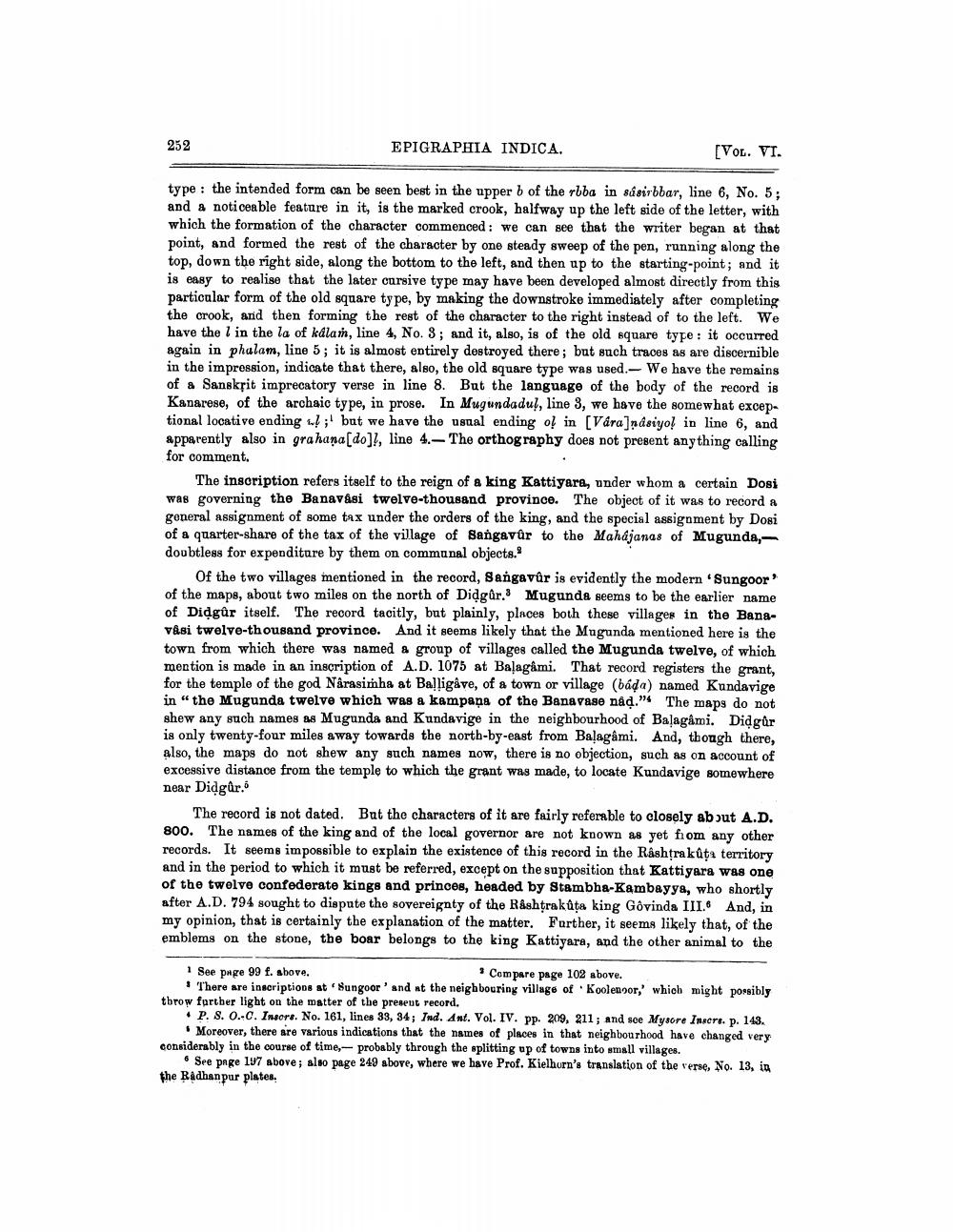________________
252
EPIGRAPHIA INDICA,
[Vol. VI.
type: the intended form can be seen best in the upper b of the roba in sásirbbar, line 6, No. 5; and a noticeable feature in it, is the marked crook, halfway up the left side of the letter, with which the formation of the character commenced: we can see that the writer began at that point, and formed the rest of the character by one steady sweep of the pen, running along the top, down the right side, along the bottom to the left, and then up to the starting-point; and it is easy to realise that the later cursive type may have been developed almost directly from this particular form of the old square type, by making the downstroke immediately after completing the crook, and then forming the rest of the character to the right instead of to the left. We have the l in the la of kalam, line 4, No. 3; and it, also, is of the old square type: it occurred again in phalam, line 5; it is almost entirely destroyed there; but such traces as are discernible in the impression, indicate that there, also, the old square type was used.- We have the remains of a Sanskrit imprecatory verse in line 8. But the language of the body of the record is Kanarese, of the archaic type, in prose. In Mugundadul, line 3, we have the somewhat exceptional locative ending ?;! but we have the usual ending of in (Vára]násiyo! in line 6, and apparently also in grahana[do]!, line 4.- The orthography does not present anything calling for comment.
The inscription refers itself to the reign of a king Kattiyare, under whom a certain Dosi was governing the Banavåsi twelve-thousand province. The object of it was to record a general assignment of some tax under the orders of the king, and the special assignment by Dosi of a quarter-share of the tax of the village of Sangavûr to the Mahajanas of Mugundadoubtless for expenditure by them on communal objects.
Of the two villages mentioned in the record, Sangavûr is evidently the modern 'Sungoor" of the mape, about two miles on the north of Didgûr. Mugunda seems to be the earlier name of Didgûr itself. The record tacitly, but plainly, places both these villages in the BangVsi twelve-thousand province. And it seems likely that the Mugunda mentioned here is the town from which there was named a group of villages called the Mugunda twelve, of which mention is made in an inscription of A.D. 1075 at Balagâmi. That record registers the grant, for the temple of the god Narasimha at Balligåve, of a town or village (báda) named Kundavige in "the Mugunda twelve which was a kampane of the Banavase nâą." The maps do not shew any such names as Mugunda and Kundavige in the neighbourhood of Balagámi. Didgür is only twenty-four miles away towards the north-by-east from Balagâmi. And, though there, also, the maps do not shew any such names now, there is no objection, such as on account of excessive distance from the temple to which the grant was made, to locate Kundavige somewhere near Didgør.
The record is not dated. But the characters of it are fairly referable to closely about A.D. 800. The names of the king and of the local governor are not known as yet from any other records. It seems impossible to explain the existence of this record in the Rashtra kata territory and in the period to which it must be referred, except on the supposition that Kattiyara was one of the twelve confederate kings and princes, headed by Stambha-Kambayya, who shortly after A.D. 794 sought to dispute the sovereignty of the Rashtrakata king Govinda III. And, in my opinion, that is certainly the explanation of the matter. Further, it seems likely that, of the emblems on the stone, the boar belongs to the king Kattiyara, and the other animal to the
1 See page 99 f. sbove.
* Compare page 102 above. • There are inscriptions at Sungoor' and at the neighbouring village of Koolengor,' which might possibly tbrow farther light on the matter of the present record.
• P. S. 0. 0. Insors. No. 161, linea 33, 34, Ind. Ant. Vol. IV. Pp. 209, 211, and soe Mysore Insere. p. 143.
. Moreover, there are various indications that the names of places in that neighbourhood have changed very considerably in the course of time, probably through the splitting up of towns into small villages.
See page 197 above; also page 249 above, where we have Prof. Kielhurn's translation of the verse, No. 13, in the Radhanpur plates




